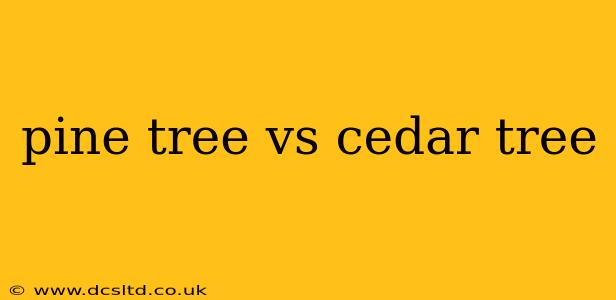Choosing between a pine and a cedar tree for your landscaping project? Understanding their key differences is crucial for making the right choice. This detailed comparison will delve into the unique characteristics of both, helping you determine which evergreen best suits your needs and preferences.
What are the Key Differences Between Pine and Cedar Trees?
The most significant differences between pine and cedar trees lie in their needles, cones, and overall appearance. While both are evergreen conifers, their unique features set them apart. Pines typically have needles bundled in groups (fascicles), while cedars have scale-like or awl-shaped leaves. Their cones also differ drastically in shape and size. Let's explore these differences in detail.
How Do Their Needles Differ?
Pine Needles: Pine trees are easily identifiable by their needles, which are usually bundled together in groups of two, three, or five, depending on the species. These bundles are called fascicles and are an essential characteristic for distinguishing pines. The needles themselves are typically long, slender, and flexible.
Cedar Needles: Cedars, on the other hand, don't have needles in the same way pines do. Instead, they have scale-like or awl-shaped leaves that are closely pressed against the branches. These leaves are much shorter and less flexible than pine needles.
What About Their Cones?
Pine Cones: Pine cones are generally woody, cone-shaped structures that can vary significantly in size and shape depending on the species. They often persist on the branches for several years, even after the seeds have been dispersed.
Cedar Cones: Cedar cones are quite different. They are typically small, berry-like, and often fleshy or soft, unlike the woody cones of pines. These cones often disintegrate after releasing their seeds.
What are the Different Types of Pine and Cedar Trees?
The world boasts a vast array of pine and cedar species, each with its unique traits. Some popular pine types include:
- Scotch Pine (Pinus sylvestris): Known for its reddish-brown bark and adaptable nature.
- Eastern White Pine (Pinus strobus): A tall, majestic pine with long, soft needles.
- Ponderosa Pine (Pinus ponderosa): A large, drought-tolerant pine with distinctive bark.
Popular cedar species include:
- Eastern Red Cedar (Juniperus virginiana): A common North American cedar with scale-like leaves and berry-like cones.
- Atlantic White Cedar (Chamaecyparis thyoides): Thrives in wet, swampy areas.
- Incense Cedar (Calocedrus decurrens): Known for its fragrant wood and flattened sprays of leaves.
Are Pine and Cedar Trees Easy to Maintain?
Both pine and cedar trees are relatively low-maintenance once established. However, they have different needs. Pines are generally more tolerant of various soil types and conditions, while some cedar species prefer well-drained soil. Regular watering, especially during dry spells, is beneficial for both. Pruning is generally minimal unless shaping is desired.
What are the Common Uses of Pine and Cedar Trees?
Both pines and cedars have been utilized for centuries for their wood and other properties:
- Pine: Widely used in construction (lumber, plywood), paper production, and resin extraction. Pine wood is known for its strength and durability.
- Cedar: Highly valued for its aromatic wood, used in construction, cabinetry, and crafting. Cedar's natural oils are insect-repellent, making it ideal for chests and closets.
What are the Differences in Scent and Aroma?
Pine: Pine trees often emit a fresh, slightly resinous aroma, particularly when their needles are crushed.
Cedar: Cedars have a strong, distinctive, and often sweet fragrance, thanks to the aromatic oils present in their wood and leaves. This fragrance is often described as woody, spicy, and slightly lemony.
Which Tree is Better for Landscaping?
The "better" tree for landscaping depends entirely on your specific needs and preferences. Consider factors like:
- Available space: Some pines and cedars can grow quite large.
- Soil type and drainage: Research the specific needs of each species.
- Sunlight exposure: Most pines and cedars require ample sunlight.
- Desired aesthetic: Pine trees often have a more open, less dense appearance than cedars.
- Fragrance: Consider whether you prefer the scent of pine or cedar.
By carefully weighing these factors and understanding the distinct characteristics of each tree, you can make an informed decision that complements your landscape perfectly. Remember to consult local arborists or gardening experts for advice tailored to your specific climate and soil conditions.
